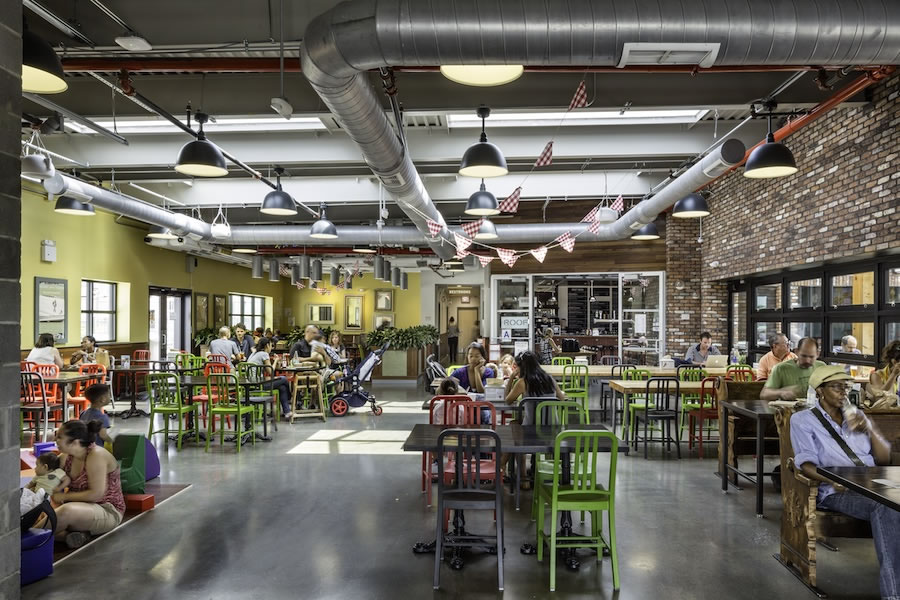More than 10 years ago, the current home of Brooklyn’s shiny, sustainable new Whole Foods Market in the Red Hook neighborhood was strewn with junky automobiles and debris from the spot’s previous 200 years spent serving as a coal storage and processing area, trucking company, freight depot, and junkyard (among other various, garbage-purveying operations). “To say the site was a mess would be a significant understatement,” says Rainer Muhlbauer, principal and director of architecture on the project and for BL Companies, which handled a multitude of responsibilities on the Whole Foods undertaking. Here, we check out how he and his team transformed the site into Brooklyn’s greenest grocery store.

PROJECT
LOCATION Brooklyn, NY
Client Whole Foods Market
Size 56,000 ft 2 with 20,000 ft 2 of hydroponic greenhouse space on the roof
Completion December 2013
Program Grocery Store, Rooftop Hydroponic Greenhouse, Beer Garden, Dining Areas, Offices, Community Room, Back of House Spaces, Car Parking
Certification LEED Platinum, Four Green Globes, EPA GreenChill Platinum
Awards AIA New York Committee on The Environment (COTE) 2014 Proof & Beauty Awards – Merit Award
Cost Withheld
TEAM
Architect BL Companies
Civil Engineer BL Companies
Structural Engineer BL Companies
Land Surveying & Subsurface Utlity Engineering BL Companies
Environmental Scientists BL Companies
Sustainability Consultant EME Group
Landscape Architect Cunningham Engineering
Energy Efficient Services E2S
Hydroponic Greenhouse Design Gotham Greens
Refrigeration Engineering Supermarket Technical Services
Construction Manager CM+B Construction Management
SUPPLIERS
Solar/Wind-powered Car Charging Stations, Wind Turbines Urban Green Energy
Photovoltaic System Solaire Generation
Water Harvesting Systems Wahaso Water Harvesting Solutions, Inc. Porous Pavers Unilock New York, Inc.
Combined Heat & Power Unit Systecon
LANDING LEED
A multitude of elements led the project to achieve LEED Platinum, each largely stemming from, as Muhlbauer says, “sun, wind, and water.” A 20,000-square-foot hydroponic greenhouse on the roof provides an abundance of fresh produce to the store below throughout the year while also keeping the roof cool in the summer and warm in the winter. Additionally, solar parking canopies produce 320 kilowatts of electricity while “sky pumps” use wind generation and photovoltaics to provide power for electric car charging stations and parking lot lighting. Muhlbauer notes that this combination results in 2.5 million kilowatt hours saved per year, making the store 60% more efficient than any other grocery store in the country. He also notes that perhaps one of the most significant achievements is the fact that the Whole Foods is the first grocery store in the country to completely eliminate Freon gas emissions in an effort to reduce the depletion of the ozone layer.
REDUCE, REUSE, RECLAIM
The dilapidated site took ample due diligence, as the entire project took more than 10 years. “Along the canal, the existing bulkhead was rotting and collapsing into the water, which was filthy and filled with garbage,” Muhlbauer says. “It took a lot of imagination to envision what has been built today.” Part of that imagination came in the form of reclaimed materials— specifically a brick skin made from 250,000 reclaimed bricks from a former Westinghouse factory in Newark. Additionally, reclaimed wood from the Coney Island Boardwalk that was destroyed by Superstorm Sandy was also used throughout the interior of the supermarket.
GREYWATER, MEET RAINWATER
Although Whole Foods originally wanted a greywater system to support toilet flushing in the store, water harvesting solutions company Wahaso soon learned that the total demand far exceeded the bathrooms’ supply. So, they added rainwater (which Muhlbauer notes runs off the solar parking canopies and stores in a 30,000-gallon tank under the parking lot—treated through a “back- of-house” water purification system and used for washing hands and flushing toilets) in a hybrid approach, which required no additional water processing costs and significantly boosted the overall water savings for the property. “Once we were collecting and storing rainwater, it was logical to add irrigation to the uses of the non-potable water,” adds John R. Bauer, president of Wahaso. “We think the idea of evaluating all potential sources and uses of non-potable water for every project is essential in maximizing total water savings.”
A GROUP EFFORT
Muhlbauer notes that Tristam Coffin was the driver behind many of the ideas explored, such as the hydroponic greenhouse and solar parking canopies (both firsts for the Whole Foods brand). “His task was to tap into the collective expertise of the entire design and construction teams to explore what could be accomplished,” Muhlbauer says. “I really believe that the results wouldn’t have been attained if left up to a single person or single consultant; it was the collaboration that led to the richness of ideas that were incorporated.” Certainly reaping the benefits of this massive collaboration are the Brooklynites enjoying the store’s beer garden and access to the waterfront, both of which have led the spot to become “a neighborhood gathering place that lends itself to much more than simply grocery shopping.”



